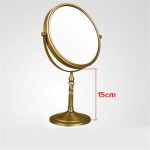What Type of Image Can a Convex Mirror Produce?
Convex mirrors, also known as diverging mirrors, are spherical mirrors where the reflective surface curves outward. This outward curvature causes light rays to diverge or spread out after reflection. Consequently, convex mirrors produce a unique type of image with distinct characteristics, making them valuable in various applications. This article will delve into the nature of images produced by convex mirrors, exploring the key aspects that define their properties.
Image Characteristics
Convex mirrors always produce virtual, upright, and diminished images. These characteristics set them apart from concave mirrors, which can produce both real and virtual images. Let's break down each characteristic individually.
1.
Virtual Image:
A virtual image is an image formed by the apparent intersection of reflected or refracted light rays. It cannot be projected onto a screen since the rays do not actually converge at that point. In the case of convex mirrors, the reflected rays appear to diverge from a point behind the mirror, creating a virtual image.2.
Upright Image:
Another defining feature of convex mirrors is their ability to produce upright images. Unlike concave mirrors, which can produce both upright and inverted images depending on the object's position, convex mirrors always render the image upright. This means that the image appears in the same orientation as the object.3.
Diminished Image:
Convex mirrors always produce images that are smaller than the actual object. This size reduction is directly related to the diverging nature of the mirror. Since light rays spread out after reflection, they appear to originate from a point closer to the mirror than the actual object, leading to a diminished image.Ray Diagram Illustration
To visualize the formation of images in a convex mirror, consider a ray diagram. A ray diagram is a simple graphical representation that shows the path of light rays as they reflect off a curved surface. The intersection point of the reflected rays determines the location of the image. In the case of a convex mirror, the following two rays are crucial for constructing the image:
1. A ray parallel to the principal axis: This ray, after reflection, appears to diverge from the focal point (F) of the mirror. The focal point is the point where parallel rays converge after reflection from a concave mirror or appear to diverge from in the case of a convex mirror.
2. A ray passing through the center of curvature: This ray, after reflection, retraces its path back along the same line. The center of curvature (C) is the center of the sphere from which the mirror is a part.
By drawing these two rays, we can see that the reflected rays diverge behind the mirror, seemingly originating from a point closer to the mirror than the object. This intersection point represents the virtual, upright, and diminished image.
Applications of Convex Mirrors
The unique image characteristics of convex mirrors make them suitable for a wide range of applications, including:
1.
Rearview Mirrors:
Convex mirrors are commonly used as rearview mirrors in vehicles due to their wide field of view. This wide view allows drivers to see a larger area behind them, improving safety by alerting them to approaching vehicles or obstacles.2.
Security Mirrors:
Convex mirrors are often used for security purposes in shops, banks, and other public places. Their wide field of view enables them to cover a larger area, helping to monitor movement and deter theft.3.
Street Corners:
Convex mirrors are frequently installed at street corners to provide drivers with a better view of oncoming traffic and pedestrians, especially in blind spots. This enhanced visibility helps to prevent accidents.4.
Telescopes:
Certain types of telescopes, like Newtonian reflectors, use a convex mirror as the primary mirror. This mirror reflects light from distant objects towards a secondary mirror, which then directs the light to the eyepiece.Can A Convex Mirror Produce Real Image
Can A Convex Mirror Form Magnified Image Quora

Can A Convex Mirror Produce Real Image When The Object Is Virtual And Vice Versa Concave If Yes How Will It Be Possible Why Quora
Can A Convex Mirror Produce Real Image When The Object Is Virtual And Vice Versa Concave If Yes How Will It Be Possible Why Quora
Can A Convex Mirror Form Real Image Quora
Can Convex Mirrors Produce Lateral Inversion Quora

Convex Mirror Image Formation Conditions Ray Diagram Uses

Convex Mirror Uses Of Definition Equation

05 Convex Mirrors

Convex Mirror Image Formation Conditions Ray Diagram Uses








